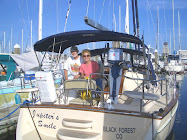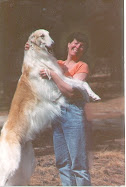
Barb returned from her visit with the Dangerous Babe’s in Puerto Vallarta to Roatan on March 29th. Despite her long, tiring journey, Barb wanted us to get on our way and out of Roatan, so we left the next morning. The winds were out of the East, but light, so our eastbound journey (motoring) was comfortable. We made our way to Guanaja and entered a cut through the reef at Soldado Channel. We sat at anchor, all alone for two days, enjoying the solitude and the beauty of the Michael’s Rock region. As we walked the beach, swam and snorkeled, a few local men had been busily constructing a site on the shore to celebrate the upcoming Semana Santa holiday and on the third day they began burning the left over materials, upwind, so the smoke blew toward us. We departed for a new anchorage less than two miles to the southwest, Blue Rock, and enjoyed the remainder of a quiet day alone again. The next day we rounded the end of the island to go to Bonacca town to top up our fuel, get final provisions and visit the officials to check out of Honduras declaring our next destination to be Bocas del Toro, Panama, about 600 nm away.
On his fourth and final voyage during the late summer of 1502, it took Christopher Columbus and his crew 28-days to tack eastward along the coast of present-day Honduras. “Other tempests I have seen,” Columbus reported, “but none that lasted so long or so grim as this.” Upon reaching a point that is now close to the border with Nicaragua he proclaimed, “Thanks to God!” The tip of the peninsula still bears that name, Cabo Gracias a Dios. The source of his difficulty was the strong Trade Winds that blow generally out of the east. The seas tend to build to uncomfortable heights. The decks would be continually wet and the crew would be sorely tested by the need to tack against the wind and current.
Using a variety of forecasting tools, modern day sailors watch for a period of favorable weather before they venture out in these waters. So the prudent cruiser waits for the weather window where either the winds die down and the seas moderate so they can motor-sail or they wait for a shift in the wind toward the North so they can sail eastward under sail alone.
If the winds die, we can turn on the motor and make the first leg of the trip in about thirty hours in seas with a manageable swell. But, we are a sailboat and I resist motoring if I can harvest the wind instead. That means we watch and wait as patiently as we can for a wind shift that will last long enough to make the passage, but not blow so hard that comfort is compromised. This was our plan as we waited at El Bight just north of Bonacca Cay. We waited for three days discussing the weather forecasts with Damiana, Tempest, Pelican’s Flight, Tisha Baby and Jacana. As the Trade Winds continued to blow, several vessels arrived from the east and departed westward. On Monday, the winds were down, but still out of the east. Damiana departed and we decided to follow their lead as they reported favorable conditions – at first. We noticed, as we made our way out of the anchorage that they had turned around. They were about a half hour ahead of us and reported that they had waves over their bows (they are a catamaran) and that they were returning. We returned too. Around noon, the wind was still down and the seas had settled and Damiana left and headed east. We did not follow this time.
At dawn the next morning, Tempest, Pelican’s Flight and then, soon after, Jacana filed out of the anchorage and through the cut near Half Moon Cay on a heading of about 100-degrees. We had all discussed the forecast and our weather advisor, Chris Parker on the Caribbean Weather Net, had advised that we leave on Monday and motor to arrive at the Vivarillo Cays ahead of the approaching cold front, which is what Barb and I thought we would do and what Damiana did. Chris Parker’s second choice was to go on Tuesday with more wind, sailing ahead of a cold front and then ride the front. That would provide wind from the north and an opportunity to sail. However, the front would also bring strong winds of possibly over 35 knots, in squalls on Tuesday night. We didn’t like that “window” very much. Having missed the motoring opportunity on Monday with Damiana and seeing the three boats leave Tuesday morning to face the cold front (they had said, “We have big boats (around 45-50 feet), we can take it.”) we began to suffer from being left behind. After two hours of discussion (rationalizing) with Tisha Baby on the radio and getting forecasts revising wind speeds downward, we left the anchorage motoring northeast behind the reef and met Tisha Baby as they left Josh’s Cay. We both went out the North East Cay Channel two miles north of our anchorage’s latitude. We raised our sails before we even cleared the cut. Once clear, we made for a heading of 85-degrees while Tisha Baby motor-sailed even higher at 80-85 degrees. Our first destination, the Vivarillo Cays, is on a heading of 103-degrees from Guanaja, but Richard and I agreed that once the front came through with northerly winds, it would be better to be able to turn downwind toward our destination, so we were trying to get as far east as possible as soon as possible. Tisha Baby was trying to get a little northeast, in fact, so they would have more room to run if need be. The other three boats, having left about two hours before we did, were motor-sailing in good conditions and, being bigger, were making more speed than we were. Jupiter’s Smile was making 6.6 – 6.8-knots with the sails up and the motor on with a north wind of 8-knots in 2-3-foot chop over a 2-foot swell. We all continued motor-sailing this way until the wind picked up to 12-14-knots at about 3 pm. We turned off the motor and continued under sails alone at 6.2 -- 6.6-knots in 2-ft chop and virtually no swell. By 5 pm the wind had freshened to 16-22-knots and with dusk approaching we decided to shorten sail. Dusk and dawn are at about 6 pm and 6 am respectively at these latitudes year round. We took in the headsail completely, left the staysail full and put in the equivalent of two reefs in the mainsail. We have roller furling on all three of our sails so we have continuous reefing capabilities, not fixed reef points. We usually reduce sail at night so that the person on watch does not need to adjust anything in the dark and we sail more slowly so that if there is something in the water we don’t see, we don’t hit it so hard. By 8 pm, we frequently had winds of 30 knots out of the north and I had reefed the staysail as well. By 10 pm, we had 8-10-ft seas and we were running with sails no higher than the spreaders on the mast, still making 5.7 knots, heading about 107-degrees (a little downwind) so the deck was wet with spray but we seldom took any waves on deck. The motion of the boat was not violent, but by no means gentle and Barb became seasick. As we sailed through the night, maintaining good speed, our hourly radio contacts with the other boats indicated that our strategy of maintaining our latitude earlier in the day was allowing us to indeed run a little downwind with seas a little behind us and we were catching up to the three boats that had left before us. Everyone was reporting a very rough ride and our wind instrument recorded a true gust of 39.4-knots. Tisha Baby was sure we had 12-foot seas. As dawn broke the wind dropped below 30 knots more frequently and the seas seemed to decrease a little…or, was I just hoping that they were? We had decided to change our destination to the Hobbies Keys, a little north of the Vivarillos. There we could get out of the big seas sooner, as long as we could clear the reef without having to negotiate any breakers. As we approached the reef we knew from our radio contacts that we had passed the three boats farther to the south of us during the night and that they would need to head more into the wind and seas to reach the Hobbies, but that they would be using a wider and more used cut that would certainly have no breakers. Tisha Baby was about an hour behind and north of us and we both decided to use a cut directly in front of us about 6 miles north of the wider one IF the opening was indeed safe. If we saw breakers, we would need to turn south to the cut that the other boats would be using and probably meet the first of the three boats there at the same time. At about 10am, we saw that the opening in the reef was relatively calm and with the sun high and bright enough to be able to read the water depths, we knew it was plenty deep and wide. Even though the wind was still blowing in the 20s, the seas were completely calm inside the reef and we let out all our sails again and went screaming toward our anchorage, still over twelve miles away. We were snuggly anchored near Damiana and three other boats by noon and Tisha Baby came in to anchor about a half hour later. Two hours later Pelican’s Flight anchored, followed soon after by Tempest and later, Jacana. Barb had recovered once we entered the reef and she got lunch prepared. We cleaned up and went to sleep early.
Looking back on the experience, we did better than the Admiral of the Seas did, but we had five hundred years of technology to help us do better. We covered 165 nm by motor-sailing eight hours and sailing twenty hours. We had fourteen hours of benign weather and fourteen hours of trying conditions. The boat and all its systems performed wonderfully and at no time did we feel unsafe or in danger. Barb was seasick and that was unfortunate, but to her credit she stayed in the cockpit; there if I needed her. The largest of the five boats, Tempest had the worst trip. Annette gets seasick like Barb and was. In the seas, their topping lift (that supports the mizzen sail’s boom while the sail is furled) became loose and it swung into the blades of their wind generator breaking the blades and cutting the topping lift. I believe that was the only physical damage. We all made it safely, thankfully. Gracias a Dio.




